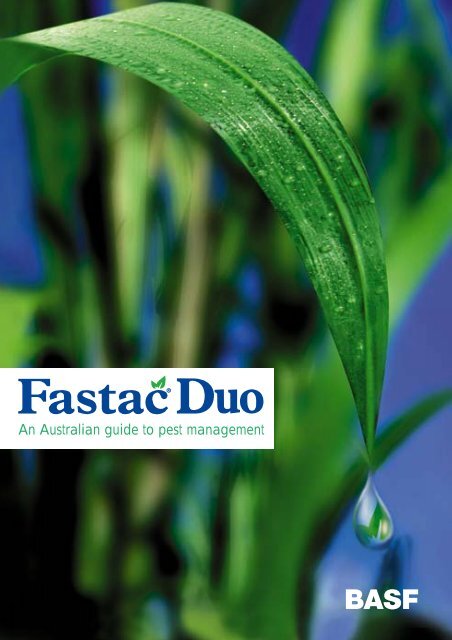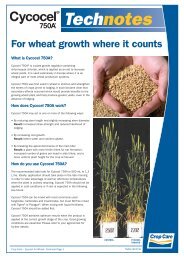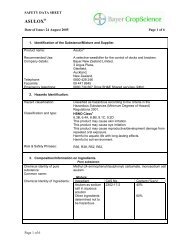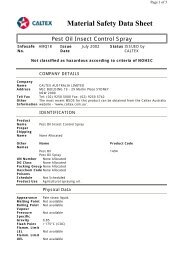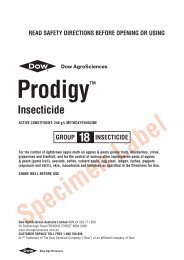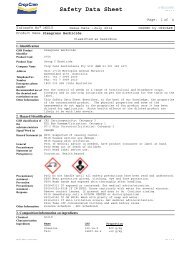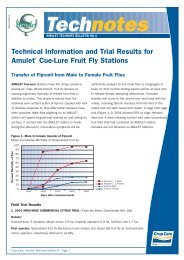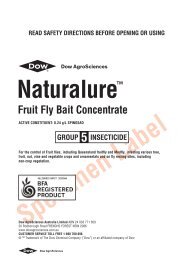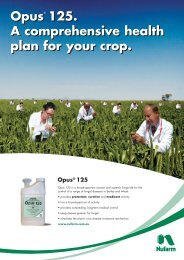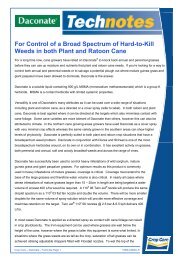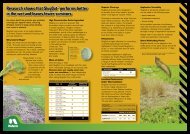Fastac Duo Technical Manual - Pest Genie
Fastac Duo Technical Manual - Pest Genie
Fastac Duo Technical Manual - Pest Genie
Create successful ePaper yourself
Turn your PDF publications into a flip-book with our unique Google optimized e-Paper software.
An Australian guide to pest management
C o n t e n t s<br />
The Product<br />
1 <strong>Fastac</strong> <strong>Duo</strong> - A Remarkable Insecticide<br />
2 <strong>Fastac</strong> <strong>Duo</strong> - Flexible Application<br />
3 <strong>Fastac</strong> <strong>Duo</strong> - Registered <strong>Pest</strong>s & Crops<br />
4 <strong>Fastac</strong> <strong>Duo</strong> - Environmental Studies<br />
7 Insecticide Resistance<br />
8 <strong>Fastac</strong> <strong>Duo</strong> - Spray Timing Charts Eastern States<br />
9 <strong>Fastac</strong> <strong>Duo</strong> - Spray Timing Charts We s t e rn Australia<br />
The <strong>Pest</strong>s<br />
10 Redlegged Earth Mite and Blue Oat Mite<br />
12 Bare earth control of Redlegged Earth Mite<br />
13 Pasture Cockchafers<br />
14 A p h i d s<br />
15 A rm y w o rm<br />
16 Pea We e v i l<br />
17 Native Budworm<br />
18 Brown Pasture Looper<br />
C u t w o rm<br />
19 Vegetable We e v i l<br />
We b w o rm<br />
20 Cabbage Moth<br />
21 Australian Plague Locust<br />
F u rther Inform a t i o n<br />
22 N o t e s<br />
23 Safety Directions and First Aid<br />
24 Contact Details<br />
This guide is designed to be used in conjunction with the product label provided.<br />
Please refer to inside back cover for the complete FA S TAC <strong>Duo</strong> label.<br />
If your copy is missing - contact BASF Australia Ltd on 1 800 501 940<br />
for further inform a t i o n .<br />
C I D 3 0 1
Active Constituent: 100 g/L alpha-cyperm e t h r i n<br />
A Remarkable Insecticide<br />
FA S TA C ® <strong>Duo</strong> is a contact and residual synthetic<br />
pyrethroid insecticide. It can be used as a protective<br />
treatment when applied at regular intervals or as a<br />
knockdown treatment to control existing infestations.<br />
The product can be applied mixed either with water<br />
carrier or oil based bulking agents such as<br />
low<br />
d o s e<br />
D - C - T R O N † cotton spray oil or compatible ULV<br />
p r o d u c t s .<br />
Some Advantages<br />
• One formulation for all<br />
applications: EC or ULV.<br />
• ” E n v i r o n m e n t a l l y, the best<br />
insecticide we have ever made.”<br />
• Active against most commercially<br />
i m p o rtant pests.<br />
• E ffective against many insects<br />
resistant to other non-synthetic<br />
pyrethroid insecticides.<br />
• Can be used as a high volume,<br />
low volume or ultra low volume<br />
a p p l i c a t i o n .<br />
• Has repellent and antifeedant<br />
e ff e c t s .<br />
• Low dose rates minimise the<br />
environmental impact.<br />
• Minimal hazard to non-target<br />
s p e c i e s .<br />
• Can be used on a wide variety<br />
of crops<br />
e<br />
which allows<br />
ff<br />
year<br />
e c t i v e<br />
round usage.<br />
• Convenient pack sizes of 5L,<br />
20L and 200L.<br />
• New arm y w o rm control rate in<br />
winter cereals.<br />
• New registration for RLEM bare<br />
e a rth pre-emergent control.<br />
1
Flexible Application<br />
Low Volume and High Volume applications by<br />
ground rig or aircraft when FA S TAC <strong>Duo</strong> is applied<br />
with a water carrier:<br />
FA S TAC <strong>Duo</strong> can be applied by ground or aircraft<br />
with a water carrier. Thorough coverage is<br />
essential to ensure adequate control. Always apply<br />
with a non-ionic surfactant unless detailed on the<br />
label or a tank mix part n e r. Apply during the<br />
cooler part of the day or night.<br />
Ground application - water carrier:<br />
For low volume spraying of field crops with ground<br />
rigs, use a total volume or 50-200 L/ha, except for<br />
sweet corn, tomatoes and tobacco where higher<br />
volumes should be used. Drop arms should be<br />
used on ground rigs in row crops taller than 30 cm<br />
(0.3 m). The application should be made as a fine<br />
s p r a y, preferably using hollow cone nozzles, unless<br />
o t h e rwise directed in the Critical Comments.<br />
Aerial application - water carrier: Use a minimum<br />
spray volume of 20 L/ha. For spring/early summer<br />
application to cereals, linola, canola, rice and to<br />
other dense crops, apply in a total spray volume of<br />
30 to 35 L/ha. If possible, spray in a crosswind.<br />
Avoid spraying in calm conditions or when wind is<br />
light and variable in direction. Apply as a spray of<br />
100-150 microns VMD. Do NOT apply to trellis<br />
tomatoes by aircraft.<br />
Ultra Low Volume (ULV) application by aircraft:<br />
FA S TAC <strong>Duo</strong>, mixed with D-C-TRON cotton<br />
spray oil or other compatible products should be<br />
applied in a minimum total spray volume of 1.5<br />
L/ha. It should only be applied by aircraft with<br />
suitable equipment to provide a droplet size of<br />
approximately 80-100 microns VMD. Applications<br />
should be made during the cooler parts of the<br />
day or night. Avoid application in calm or very<br />
windy conditions. Preferably apply in light to<br />
moderate cross winds.<br />
Misting machines:<br />
These, generally will NOT provide the same level of<br />
control as a boom due to poor coverage, so are<br />
not recommended.<br />
S u rf a c t a n t :<br />
The addition of a non-ionic surfactant at label rates<br />
per 100 litres of spray mix will improve droplet<br />
deposition and control when using a water carrier.<br />
R a i n f a s t n e s s :<br />
Best results are obtained if heavy rain does not<br />
occur within 6 hours after application.<br />
Length of Control:<br />
FA S TAC <strong>Duo</strong> kills pests through contact and<br />
ingestion. The active ingredient in FA S TAC <strong>Duo</strong>,<br />
a l p h a - c y p e rmethrin, is only slightly soluble in<br />
water and therefore is not degraded in the same<br />
manner as other insecticides.<br />
C o m p a t i b i l i t y :<br />
Low Volume and High Volume applications by<br />
ground rig or aircraft when FA S TAC <strong>Duo</strong> is applied<br />
with water carrier:<br />
This product is compatible with Dithane † M 45 ,<br />
dicamba, Kelthane † EC, Kocide † , NUDRIN ®<br />
Insecticide, NUDRIN ® 225, Parathion 500 EC,<br />
Parathion M500, Predator † 300, Ridomil † , Wu x a l † ,<br />
S e l e c t † , dimethoate, paraquat, diquat, glyphosate,<br />
Ti g r e x † , Jaguar † , simazine, SPINNAKER ® , 2,4-D<br />
amine and ester, 2,4-DB and MCPA. Do NOT mix<br />
FA S TAC <strong>Duo</strong> with wettable powders and water<br />
dispersible granules BEFORE addition to the spray<br />
tank. FA S TAC <strong>Duo</strong> can be mixed with Dithane<br />
WDG providing the mixture is agitated eff i c i e n t l y<br />
and used immediately.<br />
Ultra Low Volume (ULV) application by aircraft:<br />
This product should be used only with specific ULV<br />
f o rmulations of other insecticides, e.g. NUDRIN<br />
225, Predator 300 and PBO synergists, when<br />
mixed according to the directions on the PBO<br />
synergist labels.<br />
2
M i x i n g :<br />
FA S TAC <strong>Duo</strong> mixes readily with hard and soft<br />
w a t e r. Add the required quantity of FA S TA C<br />
<strong>Duo</strong> to water under agitation. Do not allow<br />
mixed solution to stand for longer that 16<br />
hours. In extremely alkaline water (pH9), spray<br />
immediately after mixing, or use a proprietary<br />
neutralising agent.<br />
Environmental considerations:<br />
FA S TAC <strong>Duo</strong> is of low hazard to the user and the<br />
environment when used in accordance with label<br />
directions.<br />
Always consult the label for full application<br />
i n s t r u c t i o n s .<br />
More <strong>Pest</strong>s More Crops.<br />
- A Truly Versatile Insecticide.<br />
Registered <strong>Pest</strong>s<br />
Registered Crops<br />
A p h i d s<br />
Apple We e v i l<br />
Banksia Moth<br />
Blackheaded Pasture Cockchafer<br />
Blue Oat Mite<br />
B o l l w o rm<br />
Brown Pasture Looper<br />
Cabbage Moth<br />
Cabbage White Butterf l y<br />
Cluster Caterpillar<br />
Common Arm y w o rm<br />
C u t w o rm<br />
Garden We e v i l<br />
Green Mirid<br />
Grey Cluster Bug<br />
B a n k s i a<br />
B r o c c o l i<br />
Brussels Sprouts<br />
C a b b a g e s<br />
C a u l i f l o w e r s<br />
Chinese Cabbage<br />
C a n o l a<br />
Cereals (winter)<br />
Cotton<br />
Eucalypt Plantations<br />
Field Peas<br />
Grape Vi n e s<br />
K a l e<br />
K o h l r a b i<br />
L e t t u c e<br />
L i n o l a<br />
L i n s e e d<br />
Helicoverpa arm i g e r a<br />
Helicoverpa punctigera<br />
Pea We e v i l<br />
Plague Locust<br />
Plague Thrips<br />
Redlegged Eart h m i t e<br />
Rough Bollworm<br />
Rutherglen Bug<br />
Sorghum Midge<br />
S o u t h e rn Arm y w o rm<br />
Tasmanian Eucalyptus Leaf Beetle<br />
Tobacco Looper<br />
Vegetable We e v i l<br />
We b w o rm<br />
Wingless Grasshopper<br />
L u c e rn e<br />
- (Seed and Forage crops)<br />
L u p i n s<br />
M a i z e<br />
Mung Beans<br />
Navy Beans<br />
Pastures<br />
- (Legume & Grass Based)<br />
Pome Fruit<br />
R i c e<br />
S o r g h u m<br />
S o y b e a n s<br />
Stone Fruit<br />
Sun Flowers<br />
Sweet Corn<br />
To b a c c o<br />
To m a t o e s<br />
Tu rn i p s<br />
3
Environmentally the best<br />
insecticide we have ever made...<br />
An Overv i e w<br />
FASTAC <strong>Duo</strong> is a highly active synthetic pyrethroid<br />
insecticide used at relatively low rates of<br />
application. At these rates, FASTAC <strong>Duo</strong> controls a<br />
wide range of pests on most of the world’s<br />
economically important crops.<br />
Note: Reference is made to the original FASTAC ®<br />
100 EC formulation in these environmental<br />
studies. The same conclusions apply to FASTAC<br />
<strong>Duo</strong>; so to avoid confusion FA S TAC <strong>Duo</strong> is<br />
referred to in this section.<br />
It is known that FASTAC <strong>Duo</strong> and compounds<br />
related to it are not hazardous to birds and<br />
mammals when used as recommended. However,<br />
their high level of biological activity suggest that<br />
they might put at risk non-target species such as<br />
honey bees, insect predators and fish in<br />
waterways near farms. A series of extensive<br />
studies was set up, several of them unique, to<br />
investigate the behaviour of FA S TAC <strong>Duo</strong> in<br />
relation to the environment. These studies<br />
demonstrated that, despite its high level of<br />
activity against pests, FASTAC <strong>Duo</strong>, when used as<br />
recommended generally has little effect on nontarget<br />
species.<br />
Despite toxicity to bees in the laboratory -<br />
extensive field tests have established that <strong>Fastac</strong><br />
<strong>Duo</strong> has no adverse effects either short or long<br />
term when used under field conditions. This is<br />
because of the very low rates FASTAC <strong>Duo</strong> is used<br />
at in field applications, and by the fact that freshly<br />
sprayed FASTAC <strong>Duo</strong> deposits repel bees so they<br />
quickly move away from the area being sprayed.<br />
Similarly, FASTAC <strong>Duo</strong> is toxic to fish in laboratory<br />
test but has been shown to have no significant<br />
effect on them in natural water. This is again partly<br />
because of very low dose rates but also because of<br />
the unusual physico-chemico properties of<br />
FASTAC <strong>Duo</strong>. Combined, these factors prevent all<br />
but extremely low concentrations of FASTAC <strong>Duo</strong><br />
passing into the sub-surface water.<br />
Environmental studies have also shown that at the<br />
rates used for insect pest control in crops, FASTAC<br />
<strong>Duo</strong> has less effect on beneficial insects like<br />
chalcid wasps than many other widely used<br />
insecticides.<br />
These studies have demonstrated that<br />
despite the high intrinsic level of activity of<br />
FA S TAC <strong>Duo</strong>, it has a minimal effect on<br />
non-target species under practical<br />
conditions of use. FA S TAC <strong>Duo</strong> therefore<br />
o ffers a definite advance in insecticides<br />
suitable for both conventional pest control<br />
and pest management systems.<br />
Beneficial arthropods such as dragonflies, spiders<br />
and hymenopterous parasites, show only transient<br />
or no effects from exposure to FA S TA CD u o.<br />
Honey Bees<br />
For the farm e r, foraging honey bees pollinate his<br />
crops; for the bee keeper, large areas of crops like<br />
canola dramatically increase his honey production.<br />
But if the crop is attacked by pests during the<br />
flowering period the farmer needs to spray. Because<br />
FA S TAC <strong>Duo</strong> can be used to control many pests of<br />
flowering crops, considerable eff o rt has been put<br />
into establishing its safety to honey bees. A<br />
sequence of detailed experiments were carried out,<br />
beginning with simple laboratory tests and<br />
progressing stage by stage to large-scale field trials<br />
to prove this.<br />
FA S TAC <strong>Duo</strong> is known to have a deterrent<br />
e ffect on foraging bees for a short period<br />
of time after spraying. Risk to bees is<br />
reduced by spraying in early morning and<br />
late evening while bees are not foraging.<br />
4
Honey bees are frequently attracted to cereal crops<br />
where they forage honeydew secreted by<br />
aphids. Unlike nectar and pollen, which are<br />
n o rmally protected by flower petals, aphid<br />
honeydew is exposed and can be contaminated<br />
if the crop is sprayed.<br />
In the wheat study, bee hives were put inside large<br />
mesh covered tunnels placed over a crop of wheat.<br />
A sugar solution which simulated aphid honeydew<br />
was then sprayed on the crop. Once the bees were<br />
used to foraging the sugar solutions, insecticides<br />
were applied to two-thirds of the enclosed area. The<br />
rest was left untreated so the bees could choose it as<br />
an alternative area for foraging and thus show if they<br />
were repelled by any of the sprays which were used.<br />
The data 1 showed that none of the three dose rates of<br />
FA S TAC <strong>Duo</strong>, even the highest, which was up to<br />
three times the expected European commercial<br />
dose nor pirimicarb, produced any increase in bee<br />
mortality. Dimethoate, on the other had, caused<br />
large numbers of bee deaths - over 50 per cent of<br />
the total population of the hive. Residue levels of<br />
FASTAC <strong>Duo</strong> in honey and in wax collected from<br />
the hive exposed to two FASTAC <strong>Duo</strong> applications<br />
were very low.<br />
Foraging activity was greatly reduced in the areas of<br />
the tunnels treated with FA S TA C<strong>Duo</strong> or pirimicarb<br />
but it continued at almost normal levels in the part s<br />
of the tunnels which had not been treated, thus<br />
demonstrating the repellent effect of fresh deposits of<br />
these compounds. Foraging stopped in both the<br />
treated and the untreated parts of the tunnels<br />
sprayed with dimethoate † , but returned to norm a l<br />
after 24 hours.<br />
Beneficial Invert e b r a t e s<br />
The value of bees to man is well known, but there<br />
are many other useful invertebrates. Eart h w o rm s ,<br />
for example, improve soil fert i l i t y, while predatory<br />
and parasitic insects can help keep pests in check.<br />
Predator/prey systems range from simple<br />
relationships such as the use of the parasitic chalcid<br />
wasp, Encarsia form o s a , to control whitefly in<br />
glasshouses to relatively complex interactions<br />
between whole groups of predatory and plant-eating<br />
species of invertebrates found in large-scale arable<br />
crops. Whatever the case, it is clearly to man’s<br />
benefit to exploit the activities of useful species.<br />
E a rt h w o rm s<br />
The toxicity of FA S TA C<strong>Duo</strong> to<br />
e a rt h w o rms was assessed under<br />
l a b o r a t o ry conditions using a simple<br />
test method. The test involves keeping batches<br />
of worms for 14 days in a standard artificial soil into<br />
5<br />
which known concentrations of the test chemicals<br />
have been mixed. The worms are thus in direct<br />
bodily contact with the chemicals and they also ingest<br />
contaminated soil. By testing a chemical at a range of<br />
concentrations, mortality data can be used to<br />
calculate LC50 values.<br />
FA S TAC <strong>Duo</strong> was tested at various<br />
concentrations. Even at the highest rate, in<br />
the top millimetre of soil, no worms died.<br />
As this is higher than the highest Australian<br />
commercial dose rate, it seems safe to<br />
conclude that the normal use of<br />
FA S TAC <strong>Duo</strong> will not be a hazard to<br />
e a rt h w o rm populations.<br />
The Chalcid Wa s p<br />
The chalcid wasp, Trichogramma cacoeciae,<br />
parasitises the eggs of a range of Lepidoptera<br />
including arm y w o rms, bollworms and stalk borers<br />
such as Spodoptera, Heliothis and Ostrinia s p p .<br />
Trichogramma is one of the most successful of all<br />
a rthropod biological control agents. Laboratory<br />
reared specimens are used in mass release<br />
programmes to control pest populations.<br />
L a b o r a t o ry tests show that nearly all synthetic<br />
insecticides so far tested are highly toxic to adult<br />
chalcid wasps under laboratory conditions. In<br />
practice, crops are sprayed when many of the<br />
wasps are in the preadult stages is critical as far as<br />
the future population of the parasite is concern e d .<br />
A laboratory test was developed to compare the<br />
e ffects of FA S TA C <strong>Duo</strong> on preadult Tr i c h o g r a m m a<br />
with those of other widely used insecticides.<br />
1 - Reference: FA S TAC and the Environment, published 1983
By monitoring the emergence of wasps from the<br />
eggs and then their ability to parasitise fresh<br />
supplies of eggs, the test investigates the eff e c t<br />
of the chemicals on the ‘beneficial capacity’ of<br />
Trichogramma rather than simply on its surv i v a l .<br />
The effect of FA S TAC <strong>Duo</strong> was compared<br />
with that of endosulfan. FA S TAC <strong>Duo</strong> had<br />
only a minor effect on the emergence of<br />
the parasites and on their beneficial<br />
c a p a c i t y, where endosulfan was highly<br />
toxic to the wasps. FA S TAC <strong>Duo</strong> can<br />
therefore be classified as harmless to<br />
preadult Tr i c h o g r a m m a .<br />
A five-year study along with other field trials data<br />
reveal no evidence that FA S TA C <strong>Duo</strong> t r e a t m e n t s<br />
had any long term adverse effects on any of the<br />
beneficial taxa studied. The major beneficial groups<br />
included parasitic wasps, and the import a n t<br />
p r e d a t o ry groups included ground beetle<br />
(C a r a b i d a e ), rove beetles (S t a p h y l i n i d a e ) a n d<br />
money spiders (Linyphiidae). G e n e r a l l y, the other<br />
insecticides used in the trials had more effect than<br />
FA S TAC on beneficial foliage dwelling art h r o p o d s .<br />
Aquatic Organisms<br />
Tests with the invertebrate zooplankter, D a p h n i a<br />
m a g n a , and the rainbow trout, O n c h o r h y n c h u s<br />
mykiss, in pristine water showed that, as expected,<br />
FA S TA C<strong>Duo</strong> has a high level of acute toxicity under<br />
l a b o r a t o ry conditions. This high toxicity under<br />
l a b o r a t o ry conditions is common to all pyrethroid<br />
insecticides and indicates potential hazards.<br />
Further studies were set up to find out how serious<br />
these potential hazards might be in practice and<br />
to investigate the likelihood of long term problems<br />
or of any sub-lethal effects.<br />
Both the fish and Daphnia test showed<br />
there were no significant chronic or<br />
sub-lethal toxic effects from prolonged<br />
exposure to FA S TAC <strong>Duo</strong>.<br />
The limited and transient nature of FA S TAC <strong>Duo</strong>’s<br />
e ffects on invertebrate populations when used under<br />
commercial conditions contrast with its high level of<br />
acute toxicity in the laboratory.<br />
Analysis of the pond and ditch water during the<br />
small plot experiments and commercial scale aerial<br />
spraying trials showed that concentrations of<br />
FA S TAC <strong>Duo</strong> in the water were always lower than<br />
early predictions had suggested. The hydrophobic<br />
nature of alpha-cypermethrin and its very low water<br />
s o l u b i l i t y, coupled with the very low application<br />
rates, results in low concentrations of FA S TAC <strong>Duo</strong> in<br />
the body of the water. In addition, alphac<br />
y p e rmethrin molecules are adsorbed strongly onto<br />
the surface of organic matter in ponds and<br />
w a t e rways. This, and natural degradation, tends to<br />
lower the concentration in the water even furt h e r.<br />
S u m m a ry<br />
Environmentally FA S TA C <strong>Duo</strong> has shown that<br />
despite its high level of activity against pests, when<br />
used as recommended, it generally has little effect on<br />
non target species.<br />
6
Insecticide Resistance<br />
For insecticide resistance management FA S TAC <strong>Duo</strong><br />
is a Group 3A Insecticide. Some naturally occurring<br />
insect biotypes resistant to FA S TAC <strong>Duo</strong> and other<br />
Group 3A insecticides may exist through norm a l<br />
genetic variability in any insect population. The<br />
resistant individuals can eventually dominate the<br />
insect population if FA S TAC <strong>Duo</strong> or other Group 3A<br />
insecticides are used repeatedly. The effectiveness of<br />
FA S TAC <strong>Duo</strong> on resistant individuals could be<br />
significantly reduced. Since occurrence of resistant<br />
individuals is difficult to detect prior to use, BASF<br />
Australia Ltd accepts no liability for any losses that<br />
may result from the failure of FA S TA CD u o to control<br />
resistant insects. FA S TA C D u o may be subject to<br />
specific resistance management strategies. For<br />
f u rther information, contact your local supplier,<br />
BASF Australia Ltd representative or local<br />
agricultural department agronomist.<br />
In NSW and Qld, application of this product to<br />
Helicoverpa arm i g e r a l a rvae longer than 5 mm<br />
may not only be ineffective but it may increase the<br />
level of synthetic pyrethroid resistance. This product<br />
should NOT be used to treat infestations that were<br />
not controlled by an earlier application of it or<br />
another synthetic pyrethroid.<br />
Infestations not controlled by this product should be<br />
treated with an insecticide from another chemical<br />
group. Application of this product with an<br />
insecticide from another chemical group such as<br />
NUDRIN will assist with the management of<br />
synthetic pyrethroid resistant Helicoverpa arm i g e r a .<br />
7
REDLEGGED EARTH MITE<br />
(Halotydeus destructor)<br />
& BLUE OAT MITE<br />
(Penthaleus major)<br />
- Pastures & broadacre crops.<br />
Redlegged earth mite<br />
sustainable economic return. FA S TAC <strong>Duo</strong><br />
insecticide will provide excellent control of RLEM and<br />
BOM. However a basic understanding of the insect<br />
lifestyle and biology will confirm the correct timing of<br />
FA S TAC <strong>Duo</strong> application for the greatest productivity<br />
i n c r e a s e .<br />
Redlegged earth mite has a velvety black body and<br />
grows to about 1mm long with eight red legs as an<br />
adult. During the immature, or nymph, stage of its<br />
lifecycle, RLEM goes through several moults and only<br />
has six legs.<br />
A survey commissioned by the Australian Wo o l<br />
Corporation during the late 1980’s revealed that<br />
redlegged earth mite (RLEM) and blue oat mite<br />
(BOM) were the most damaging pests of pasture in<br />
Australia, resulting in over 200 million dollars in lost<br />
production to the sheep and wool industry alone.<br />
Another survey by the Kondinin Group from<br />
We s t e rn Australia, in 1995 showed that Australian<br />
graziers still rate RLEM as their major pasture pest.<br />
These surveys indicate that adequate control<br />
measures may not have been undertaken, either as<br />
a result of incorrect chemical choice or incorrect<br />
application timing. The following information deals<br />
with these topics.<br />
RLEM are believed to have been introduced from<br />
South Africa and were first recorded in We s t e rn<br />
Australia in 1917.<br />
Redlegged earth mite (RLEM) and blue oat mite<br />
(BOM) are sap sucking mites which can devastate<br />
both germinating and established pastures. They<br />
can kill seedlings by attacking the emerging<br />
coleoptile, and established pastures and can reduce<br />
production by up to 80% and seed set by up to 60%.<br />
Those plants which do survive have lower vigour<br />
and palatability.<br />
Damage to plants generally occurs at a time when<br />
there is the greatest requirement for feed from<br />
grazing livestock, ie. late autumn and early winter.<br />
RLEM are generally pests of leguminous plants such<br />
as clovers and medics, however they will also attack<br />
brassica crops such as canola and in seasons of<br />
favourable conditions, may attack cereals.<br />
The objective of any insecticide is to manage the pest<br />
population in order to provide the greatest<br />
Blue oat mite are similar to RLEM with bluish-black<br />
and pink legs. BOM can be distinguished from RLEM<br />
by a small red blotch on the back.<br />
RLEM hatch from the over-summering bodies of<br />
dead females which provide protection from high<br />
summer soil temperatures.<br />
The eggs hatch approximately 19 to 20 days<br />
following 10 to 15mm of rainfall or irrigation and<br />
when day time temperatures of below 19 0 C have<br />
been recorded for 4 to 6 days. Being aware of these<br />
conditions, which are normally associated with the<br />
“opening break”, allows a relatively accurate<br />
d e t e rmination of when damage and production loss<br />
in pastures is likely to commence.<br />
Each over-summering dead female<br />
may contain 40 eggs, which will<br />
hatch over a three to four week<br />
period. Damage may initially<br />
be more severe on light soils<br />
which favour egg surv i v a l .<br />
Once eggs have hatched, the<br />
nymphs go through several<br />
moults, which take three to five Blue oat mite<br />
weeks. They then live as adults<br />
for another two to four weeks.<br />
Adults may commence egg laying<br />
approximately 28 days after hatching, thus<br />
establishing a new generation. A typical winter<br />
generation may cause significant damage for<br />
between 7 to 10 weeks.<br />
Average population density of RLEM on legume<br />
pasture can be greater than 15,000 per square<br />
metre, or 150 million per hectare. Populations of<br />
over 10,000 per square metre have been recorded.<br />
When populations build up, earth mites become<br />
v e ry mobile and may travel several metres in search<br />
of a desirable feed source. Paddock fence lines are<br />
no barrier to attack from RLEM. The population<br />
1 0
Table 1.<br />
Weather Conditions and Spraying Ti m e s<br />
diminishes during mid-winter when cooler<br />
conditions trigger the female to lay eggs. These eggs<br />
hatch in August/September as daytime<br />
temperatures increase, resulting in the spring<br />
g e n e r a t i o n .<br />
The spring life cycle lasts about 4 to 5 weeks, half as<br />
long as the autumn/winter life cycle. Despite this<br />
s h o rter time frame, damage to pastures in the form<br />
of lost dry matter production and reduced seed set<br />
can have a devastating long term effect. If eff e c t i v e<br />
control of the winter life cycle is achieved, few<br />
females will survive to lay eggs for the next<br />
generation and therefore a problem is unlikely to<br />
occur in the spring. If control is to be attempted in the<br />
spring, spraying should commence early, before<br />
increasing temperatures encourage females to<br />
commence laying. Spraying in conjunction with<br />
spray-topping is often too late.<br />
FA S TAC <strong>Duo</strong> is a residual, synthetic pyrethroid<br />
insecticide which will provide control over the initial<br />
egg hatching period in the late autumn, thus<br />
providing long term control when used in<br />
accordance with label directions.<br />
In the past, applications of an insecticide were often<br />
delayed until RLEM damage had been identified.<br />
This was probably necessary as the insecticide used<br />
may have only had a short residual or control<br />
period, or even required application to foliage to be<br />
1 1<br />
e ffective. FA S TAC <strong>Duo</strong> overcomes these short f a l l s .<br />
RLEM & BOM Damage<br />
Damage is typically seen as whitening of leaves as<br />
the mites lacerate the leaf surface and suck out the<br />
sap, which is then replaced by air at the feeding site.<br />
If spraying is delayed until this damage is evident,<br />
pasture productivity is significantly reduced. In<br />
seasons of poor follow-up rains, after the opening<br />
break, many farmers notice that capeweed surv i v e s<br />
whilst clover content of the resulting pasture is poor.<br />
In many situations this is not only as a result of lower<br />
rainfall, but RLEM and BOM attack on stressed<br />
g e rminating and emerging seedlings.<br />
The Solution<br />
Apply <strong>Fastac</strong> <strong>Duo</strong> at the label rate within 1 to<br />
3 weeks of initial egg hatch for best long term<br />
control. Spray when mites are actively<br />
feeding. Spray seedling crops if silvering or<br />
whitening (bleaching) is causing a reduction<br />
in crop growth.<br />
Water Rates: Good coverage is essential to<br />
ensure adequate control.<br />
FA S TAC DUO
REDLEGGED EARTH MITE<br />
(Halotydeus destructor)<br />
& BLUE OAT MITE<br />
(Penthaleus major)<br />
- Bare earth control<br />
Redlegged earth mite (RLEM) is one of the most<br />
economically significant insect pests e n c o u n t e r e d<br />
during the establishment phase of broadacre<br />
cereals, legumes, canola and pasture crops.<br />
N E W<br />
Registration:<br />
100 mL/ha<br />
Their attack generally coincides with the time of<br />
gemination and emergence of susceptible crops<br />
and results in the poor establishment of healthy,<br />
vigorous seedlings, which are required to ensure<br />
maximum yield potential. Wtih particularly sensitive<br />
crops, such as canola and clover, complete<br />
decimation can be caused.<br />
RLEM are sap sucking pests which lacerate the<br />
colleoptile, cotyledons and leaves of emerging<br />
seedlings. Their attack is insidious, as the pests are<br />
often unseen until poor emergence of the crop is<br />
n o t i c e d .<br />
The Solution<br />
FA S TAC <strong>Duo</strong> is registered in canola, winter<br />
cereals, field peas, lupins and pastures for bare<br />
e a rth control of RLEM. It will provide excellent<br />
knockdown and residual bare earth control<br />
of RLEM.<br />
The application of FA S TAC <strong>Duo</strong> should occur to<br />
moist soil following sowing and prior to<br />
emergence of susceptible crops when RLEM are<br />
present. This will normally coincide with the<br />
hatching period.<br />
Application to moist soil will provide residual<br />
control, as moisture is the mechanism for<br />
absorption of FA S TAC <strong>Duo</strong> by RLEM. During<br />
periods of dry soil conditions, FA S TAC <strong>Duo</strong> is<br />
absorbed to soil particles and not available to<br />
control pests. Continued periods of the soil<br />
s u rface becoming moist and then dry will result<br />
in more rapid degradation with several<br />
m o rnings of frost or dew, followed by fine sunny<br />
a f t e rnoons. At these times, frequent monitoring<br />
of the crop and if necessary the application of a<br />
knockdown treatment, will ensure desirable<br />
levels of control are maintained. (Refer to Ta b l e<br />
1. on the previous page).<br />
FA S TAC <strong>Duo</strong> is compatible with pre-emergent<br />
herbicides such as simazine † , Spinnaker ® , and<br />
m e t r i b u z i n † , to enable one pass herbicide and<br />
insect control. FA S TAC <strong>Duo</strong> is also compatible<br />
with knockdown herbicides and insecticides<br />
such as dimethoate, which may be tank mixed<br />
for control of early infestations of lucerne flea.<br />
FA S TAC DUO 1 2
BLACKHEADED<br />
PASTURE COCKCHAFER<br />
(Aphodius tasmaniae)<br />
- Pastures<br />
The adult is a dark brown beetle approximately<br />
1cm long with a broad shovel-like head. It is<br />
sometimes mistaken for blackbeetle which attacks<br />
suburban household lawns.<br />
The larvae are a grey to white, six-legged grub<br />
with a black to dark brown head capsule. Fully<br />
grown they are up to 2cm long.<br />
The adult beetles emerge from the soil in late<br />
December to early March following summer rainfall<br />
at which time they mate and commence egg laying.<br />
The female can produce between 30 to 80 eggs.<br />
Depending on soil moisture, beetles may lay eggs<br />
in greater densities on rising positions of paddocks<br />
which generally have the barest soil surface.<br />
Blackheaded<br />
pasture cockchafer<br />
larvae<br />
consequent pasture damage occurs from May to<br />
J u l y, which coincides with the heaviest demand<br />
from the grazing animals for pasture feed.<br />
An average infestation of 300-400 larvae per<br />
square metre can cause a 50%-70% reduction in<br />
winter pasture production and a 40%-50% loss of<br />
desirable pasture species production in spring.<br />
L a rval feeding preference is for legumes (clovers)<br />
then grasses and finally broadleafed weeds such as<br />
c a p e w e e d .<br />
Cockchafer damage is multiplied when heavily<br />
infested pastures are dug up by birds such as crows<br />
and ibis in an attempt to feed.<br />
Redheaded Pasture Cockchafer<br />
Although less widespread than Blackheaded<br />
c o c k c h a f e r, they cause significant damage, to<br />
annual pastures as the larvae are totally soil<br />
dwelling and feed on the roots of pasture plants.<br />
The adult is a plump brown to black beetle<br />
approximately 13mm long and 8mm wide. The<br />
l a rvae are six legged grubs which grow to 25mm<br />
long and have a red-brown head capsule.<br />
After 4 to 5 weeks the larvae hatch but do not<br />
move to the surface to feed on decaying organic<br />
matter until rain has fallen. If rainfall does not<br />
occur within 30 days of egg hatch, up to 50% of<br />
young larvae may die. Therefore wet summers<br />
are more likely to produce severe outbreaks<br />
than dry summers.<br />
The first instar larvae only feed on organic matter.<br />
The second and third instar (late April to July) stages<br />
feed on green surface plant material and usually<br />
come to the soil surface after heavy rain or heavy<br />
d e w. After larvae have come to the surface to feed,<br />
soil casts can be seen at the opening of their tunnels<br />
and fresh foliage may be found in their tunnels.<br />
L a rvae can store sufficient food in their tunnels for<br />
6 to 8 days. If rain has not fallen for 9 to 10 days,<br />
the larvae will return to the soil surface to feed.<br />
L a rvae store fat and reduce feeding from August on<br />
and then seal themselves in the bottom of their<br />
tunnels to pupate in November and December.<br />
The period of greatest larval activity and<br />
1 3<br />
C o n t r o l :As the larvae are soil dwelling insects,<br />
e fficient chemical control is not available.<br />
If substantial numbers of larvae (in excess of 350 to<br />
400 per square metre) are monitored at the time of<br />
opening rains, consideration should be given to the<br />
cultivation of the worst affected areas. The sowing<br />
of a cereal crop to compensate for the expected loss<br />
in pasture stock feed is advised.<br />
The Solution<br />
Apply FA S TAC <strong>Duo</strong> at the label rate within 4<br />
weeks of opening rains when larvae are less than<br />
1 cm in length.<br />
It is preferable to apply by boomspray in 60 to<br />
80 litres of water per hectare as a fine spray<br />
producing a droplet size of 100-200 microns<br />
VMD. Spraying is most effective when larvae are<br />
detected and treated early.<br />
Suspect paddocks should be dug after the first<br />
substantial rain in April/May and inspected to<br />
ensure grubs are present in sufficient numbers to<br />
warrant treatment.<br />
FA S TAC DUO
A P H I D S<br />
(Rhopalosiphum s p p .)<br />
- Cereal crops<br />
Aphids affect cereals by direct feeding on plants,<br />
and/or by transmitting barley yellow dwarf virus<br />
(BYDV). BYDV affects wheat, oats and barley and is<br />
spread by flying aphids. Direct damage occurs<br />
when colonies of 10-100 aphids develop on stems,<br />
leaves and heads, from seedling stage through to<br />
Oat/Wheat aphid<br />
Rhopalosiphum s p p .<br />
head filling. The degree of damage depends on the<br />
percentage of tillers infested, aphids per tiller, and<br />
the duration of the infestation.<br />
Wheat/oat aphids vary from mottled yellow-green<br />
through to olive-green and dusky brown, to a<br />
blackish green. Colonies develop on the outside of<br />
tillers from the base upwards, on stems, nodes and<br />
backs of mature leaves, starting any time between<br />
late tillering and grain filling. Heavy infestations can<br />
blacken heads and flag leaves and are the aphids<br />
most commonly reported by farmers. Wheat/oat<br />
aphids are quite mobile and can drop to the soil<br />
and crawl to other plants. They cause yield losses by<br />
reducing grain weight and grains per head.<br />
Winged aphids fly into crops from pasture grasses<br />
or other crops and start colonies of wingless aphids.<br />
Reproduction is rapid when weather conditions are<br />
favourable, leading to population outbreaks. Plants<br />
can become sticky with honey-dew excreted by the<br />
aphids. When plants become unsuitable or<br />
overcrowding occurs, winged aphids redevelop<br />
and migrate to other plants or crops. They can<br />
c a r ry viruses in saliva or on their feeding tubes.<br />
BYDV damage is most serious after plant infection<br />
early in the season. 2<br />
2<br />
Reference: Insect and Allied <strong>Pest</strong>s of Extensive Farming.<br />
D e p a rtment of Agriculture - We s t e rn Australia. 1990<br />
The Solution<br />
In southern areas, barley crops should be<br />
checked from late tillering onwards for<br />
wheat/oat aphids on stems, backs or leaves<br />
and in the crown. Crops expected to yield 3<br />
tonnes/ha or more are most at risk.<br />
Apply FA S TAC <strong>Duo</strong> at the label rate. Sprays<br />
should be applied at 3 and 7 weeks after<br />
emergence to reduce aphid colonisation and the<br />
spread of BYDV. This will also reduce the eff e c t<br />
of feeding aphid damage.<br />
The use of FA S TAC <strong>Duo</strong> to control the spread<br />
of BYDV has shown significant yield<br />
increases in trials conducted by the We s t e rn<br />
Australian Department of Agriculture 2 .<br />
Strategic applications of <strong>Fastac</strong> <strong>Duo</strong> early<br />
post emergence at the first sign of aphid<br />
activity have proven to be a cost eff e c t i v e<br />
method of minimising the damage caused by<br />
B Y D V.<br />
2. Department of Agriculture, We s t e rn Australian Trials 1993 - M Grimm<br />
& D Pfeiff e r<br />
FA S TAC DUO<br />
1 4
SOUTHERN ARMYWORM<br />
(Persectania ewingii)<br />
COMMON ARMYWORM<br />
(Mythimna convecta)<br />
- Cereal crops<br />
Cereal crops, especially oats and barley, are an<br />
attractive source of food for several insect pests.<br />
A rm y w o rm (barley grub) is the most destructive<br />
insect pest of these crops in Eastern and We s t e rn<br />
A u s t r a l i a .<br />
The severity of outbreaks varies from year to year<br />
and district to district. Armyworm generally inflicts<br />
greatest damage to cereal crops during November<br />
or December when it “chases” moisture in the<br />
maturing crops and lops off heads. Substantial<br />
grain losses can result if the pest is not identified<br />
and controlled promptly.<br />
Common<br />
armyworm<br />
larvae<br />
NEW Rate:<br />
240 mL/ha<br />
WHP reduced:<br />
7 days har v e s t<br />
14 days stubble<br />
g r a z i n g<br />
The adult is a dark grey,<br />
night-flying moth with a<br />
wing span of 2 to 3 cm,<br />
and is normally seen<br />
during September and<br />
O c t o b e r. A rm y w o rm<br />
can be distinguished<br />
from other moths by<br />
white streaks near the<br />
leading edge of the<br />
forewing and white<br />
lines near the far end of<br />
the forewing.<br />
adult<br />
In pastures they may cause total loss of vegetation<br />
when moving as an army (normally early summer).<br />
In barley and oats, up to 70-80% grain loss may<br />
result from severe infestations over a five day period.<br />
The moth lays eggs on grasses and cereal crops<br />
which hatch a week or two later, depending on<br />
weather conditions. Arm y w o rms have three or four<br />
life cycles per year in cool wet areas. They survive<br />
over summer on self-sown cereals and grasses<br />
which germinate with summer rains.<br />
In spring it takes about three weeks from when the<br />
eggs are laid for them to hatch and for the<br />
caterpillars to reach head-lopping size. The larvae<br />
when first hatched, are small pale caterpillars<br />
approximately 2mm long which change colour<br />
when feeding commences. They may feed for a<br />
week before causing economic damage. When<br />
mature, the grubs, may vary in colour from green<br />
to brown. Growing to 4 cm in length, they can be<br />
distinguished by three white stripes on the collar<br />
(behind head). The tail piece is always brown with<br />
three white longitudinal stripes.<br />
The presence of grubs is indicated<br />
by pale yellow/green pellets<br />
h a p e d-droppings known as<br />
“frass” which can be found on the<br />
ground in the crop. Awns and<br />
other flowering parts are often<br />
found around or near frass. A<br />
sweep net or bucket can be used to sweep through<br />
the heads of the crop to assess grub numbers. In<br />
some situations, larvae lop heads at night, and may<br />
r e t u rn to the soil during the day. In these situations,<br />
assess the level of damage already caused to the<br />
crop, and the days to harvest and base a spray<br />
decision on this.<br />
photo © NSW Agriculture<br />
The Solution<br />
Apply FA S TAC <strong>Duo</strong> at the label rate when<br />
sampling reveals 2 or more grubs per m 2 .<br />
One grub can cut off up to eight heads per night<br />
and therefore spraying should always occur<br />
when grubs are small and before head lopping<br />
c o m m e n c e s .<br />
Caterpillars are most active in cooler times of<br />
d a y. Spraying early morning or later aftern o o n<br />
will provide greatest knockdown.<br />
1 5<br />
FA S TAC DUO
PEA WEEVIL<br />
(Bruchus pisorum)<br />
- Field Peas<br />
A pea weevil can be serious pest of field peas. If not<br />
controlled, it can cause significant yield losses and<br />
possible rejection of the load at the silo.<br />
The adult weevil is a brownish chunky beetle, 4 to 5<br />
mm long, which lays yellow cigar shaped eggs on<br />
young pea pods.<br />
Pea weevil<br />
photo © NSW Agriculture<br />
The adult weevil hibernates in overwintering sites<br />
such as under bark or trash around edges of<br />
paddocks. They emerge from these sites in early<br />
spring when temperatures rise above 18 0 C and fly to<br />
the nearest pea crop, where they feed on pollen for<br />
5 to 15 days. The females then lay eggs on pea<br />
pods; these eggs hatch into larvae over a period<br />
of several days. The young larvae then bore<br />
straight into the pea pod.<br />
Because insecticides can only control pea weevil<br />
larvae before they get inside the pods, it is critical<br />
to control the adult pea weevil prior to egg laying.<br />
Pea weevil larvae feed and later pupate inside the<br />
pea seed. The adults emerge over several months<br />
from late December.<br />
The Solution<br />
As there is a nil tolerance to pea weevil in<br />
e x p o rt peas, a high level of control is essential.<br />
This is why you should spray the whole paddock<br />
if populations exceed the economic threshold.<br />
A border spray may prove inadequate. Sweep<br />
netting is most effective at detecting pea weevil<br />
on calm, warm, sunny days.<br />
Monitoring the outer edges of a pea crop with<br />
a sweep net should commence from very early<br />
flowering. Apply FA S TAC <strong>Duo</strong> at the label rate<br />
when the population reaches one pea weevil in<br />
twenty five sweeps.<br />
FA S TAC DUO<br />
1 6
N ATIVE BUDWORM<br />
(Helicoverpa punctigera)<br />
- Field Peas and Canola*<br />
Native budworm are a pest of many crops.<br />
The young are voracious feeders as they<br />
attempt to rapidly gain body weight and<br />
store energy in preparation for metamorphosis<br />
to an adult moth. They may produce<br />
up to five generations per year.<br />
* FA S TAC <strong>Duo</strong> is registered to control native<br />
b u d w o rm in many crops. In this guide, field<br />
peas and canola only are referred to. Please consult<br />
the label for full directions for use<br />
adult<br />
Helicoverpa punctigera larvae<br />
The adult is a nocturnal, buff coloured moth with a<br />
wing span of 3 to 4.5 cm. The hind wings have a<br />
dark broad band on the outer margins.<br />
Adult moths emerge from soil during Aug/Sept and<br />
usually live for two to four weeks. Female moths are<br />
capable of laying up to 1000 bronze coloured eggs.<br />
The larvae grow to 5 cm long and vary in colour<br />
from green to almost black. They can be distinguished<br />
from other caterpillars by a broad yellow<br />
stripe which runs along the length of both sides of<br />
the body. Larvae hatch from eggs in 2 to 4 days<br />
and may feed for 4 to 6 weeks. The young larv a e<br />
(less that 1 cm) prefer to eat foliage while the older<br />
l a rvae prefer pods. One larvae may attack 4 to 5<br />
pods before reaching maturity.<br />
The Solution<br />
Apply FA S TAC <strong>Duo</strong> at the label rate when<br />
grubs are small (less than 1cm) and before<br />
they commence boring into pods.<br />
Crops should be monitored with a sweep net<br />
e v e ry 2 to 3 days from the start of flowering.<br />
Spraying with FA S TAC <strong>Duo</strong> should commence<br />
when sweeps collect 4 or more larvae in 10<br />
sweeps. For larger larvae (10 mm long) use<br />
the higher rate.<br />
1 7<br />
FA S TAC DUO
OTHER PESTS<br />
Brown pasture looper<br />
(Ciampa arietaria)<br />
- P a s t u r e s<br />
Brown pasture loopers are major pests of legume<br />
pastures and minor pests of legumes, oil seeds and<br />
cereals. Loopers feed on feed on foliage, capeweed<br />
b eing their favoured host. Young caterpillars feed<br />
on the leaf surface near the hatching site, where<br />
as older caterpillars may migrate from adjoining<br />
paddocks. They will devour the entire leaf tissure<br />
leaving scalloped leaves, reducing plant density<br />
and vigour.<br />
C u t w o rm<br />
(Agrotis s s p . )<br />
photos © NSW Agriculture<br />
Cutworm larvae<br />
Loopers usually have only one life cycle per year.<br />
The adult lays small cream coloured eggs in autumn,<br />
these are usually laid in groups or rafts on dry grass<br />
stalks. The moth is a grey/coppery colour about<br />
20mm long with delicate rounded wings and is<br />
strongly attracted to light.<br />
The larvae is grey/brown to green in colour with<br />
black and cream longitudinal stripes. Young loopers<br />
move with a looping motion, however adults (40mm<br />
long) do not. The main period of activity is late<br />
autumn to early spring.<br />
looper<br />
adult<br />
- Cereals and Field Crops<br />
Cutworm are a native insect pest of cereals and<br />
field crops.<br />
The adult is a stout bodied moth with a wing span of<br />
approximately 3 cm.<br />
The larvae live for about 1 month before pupating.<br />
They are characteristically smooth, plump and grey/<br />
green colour with a pink tinge. When fully grown,<br />
they can be up to 50mm long and curl up when<br />
disturbed. During the day they can be found just<br />
under the soil surface or in leaf litter, often close to<br />
a damaged plant and partly chewed leaves. They<br />
feed at night, chewing through emerged/<br />
e m e r ging plants - often felling the plant at ground<br />
level.<br />
The Solution<br />
Apply FA S TAC <strong>Duo</strong> with a minimum of 50 litres<br />
of water per hectare when infestations reach an<br />
economically damaging level.<br />
The Solution<br />
Emerging and establishing crops should be<br />
checked for caterpillars crawling on the soil<br />
surface and feeding on seedlings in the late<br />
afternoon and evening.<br />
Apply FASTAC <strong>Duo</strong> at the label rate with a minimum<br />
of 50 litres of water per hectare in the<br />
late afternoon or evening for best results.<br />
FA S TAC DUO<br />
1 8
OTHER PESTS<br />
Vegetable weevil<br />
larvae<br />
We b w o rm<br />
(Hednota s p p . )<br />
- Cereals<br />
We b w o rm larvae are pale to deep brown, tinged<br />
by gut contents with a black or dark brown head.<br />
When fully grown, the larvae are approximately<br />
15mm long. The larvae are often found in web<br />
lined tunnels from which plant parts may protrude.<br />
They can be seen above ground when conditions<br />
are cool and damp.<br />
photo © NSW Agriculture<br />
photo © NSW Agriculture<br />
Vegetable weevil<br />
(Listroderes diff i c i l i s )<br />
- Canola<br />
The adult has a typical weevil snout and is a dull,<br />
grey /brown colour approximately 10mm long with<br />
two small white blazes on its back. Larvae are yellow<br />
to green in colour with a flattened, slug-like<br />
body and a small brown head. Eggs are laid in<br />
autumn and develop into larvae in the winter. These<br />
l a rvae live up to two months before pupating.<br />
When the adults emerge, they feed until the summer<br />
when they hibernate until the following autumn.<br />
The Solution<br />
Crops should be inspected as they emerge.<br />
Border sprays are often required to control<br />
invading adults.<br />
Apply FA S TAC <strong>Duo</strong> at the label rate when<br />
cotyledons and leaves are being eaten or<br />
the plant lopped.<br />
Adults are difficult to kill so more than one<br />
spray may be required, in particular if<br />
migration from untreated areas occurs.<br />
Webworm larvae<br />
The Solution<br />
P r e - s o w i n g :<br />
E ffective control can be achieved if webworm is<br />
identified in fallow. Apply FA S TAC <strong>Duo</strong> at the<br />
label rate with a minimum of 100 litres of water<br />
per hectare. Do NOT apply to dense pasture. A<br />
minimum of 3 days should be left between<br />
spraying and sowing.<br />
FA S TAC <strong>Duo</strong> is compatible with Roundup † a n d<br />
Spray Seed † .<br />
Post Emergence:<br />
Apply FA S TAC <strong>Duo</strong> at the first sign of economic<br />
damage. If 25% of the plants show signs of<br />
damage, at or after emergence, spraying should<br />
not be delayed as the continued feeding will kill<br />
many plants, resulting in bare ground and thin<br />
areas. Most damage occurs within 3 weeks of<br />
emergence and during this period the crop<br />
should be inspected every 2-3 days.<br />
1 9<br />
FA S TAC DUO
CABBAGE MOTH<br />
(Plutella xylostella)<br />
- Brassica crops<br />
Cabbage moth is potentially the most damaging of<br />
the caterpillar pests. With the expansion of areas<br />
sown to canola, the geographical spread of this pest,<br />
p a rticularly during seasons with good finishing rains<br />
and temperatures exceeding 25 o C, is expected to<br />
encourage rapid growth in the population of P l u t e l l a .<br />
The adult is an active moth with a wing span of<br />
12-13mm. The forewings are greyish-brown<br />
and definite diamond patterns are formed on<br />
the dorsal surface when the wings are folded;<br />
hence this pest is also known as Diamond back<br />
moth in many districts.<br />
The main attack occurs in maturing crops. The<br />
young larvae damage the leaves by feeding within<br />
them, whilst older larvae generally feed from<br />
the underside of the leaf. They remove all but the<br />
upper epidermis in patches on the leaf. The upper<br />
epidermis subsequently breaks into ragged holes.<br />
Larvae feeding on pods will cause significant<br />
damage in a short period of time.<br />
The Solution<br />
Plutella larvae<br />
Eggs are greenish-yellow and disc shaped and<br />
just visible to the naked eye. They are laid singly<br />
or in clusters along the midrib on the underside of<br />
the leaf. Eggs hatch in 3-7 days. Larvae grow to<br />
about 12-13mm long, pale green, cigar-shaped<br />
and wriggle violently when disturbed. They<br />
sometimes lower themselves on silken threads.<br />
The Solution<br />
Apply FASTAC <strong>Duo</strong> at the label rate when<br />
adults are sighted in the crop in significant<br />
numbers or when the larvae present in the<br />
crop commence to cause appreciable damage<br />
to leaves and growth terminals.<br />
When reinfestation is continuous, treatment<br />
e v e ry 7-10 days may be required.<br />
Add a non-ionic surfactant at the registered<br />
rate.<br />
FA S TAC DUO 2 0
A U S T R A L I A N<br />
PLAGUE LOCUST<br />
(C h o rtoicetes term i n i f e r a)<br />
A locust outbreak, estimated to be four to six times<br />
larger than 1990, is forecast for 2000/2001.<br />
The outbreak poses immense risks to growing<br />
crops and pastures in agricultural and pastoral<br />
regions of Australia. The permit extends the registered<br />
label for <strong>Fastac</strong> <strong>Duo</strong> to the onground control<br />
of locusts.<br />
The key to successful control of the plague will be<br />
the application of effective insecticides (to control<br />
nymph locusts on the ground) in order to prevent<br />
the formation of flying swarms.<br />
Adults of the Australian plague locust may be<br />
readily distinguished from other species by the<br />
large dark spot on the tip of the hindwings and<br />
distinctive scarlet hindleg shanks.<br />
Adult body colour is variable and can be grey,<br />
brown or green. Adult males measure 25-30 mm<br />
long while females are 30-42 mm long.<br />
The nymphs have five growth stages or instars. At<br />
each stage the developing wings become more<br />
noticable. First instar nymphs are about 3mm<br />
long, pale brown to dark brown or black, and<br />
sometimes have a white stripe along the back of<br />
its first body segment just behind the head. Later<br />
instars are grey or brown and sometimes have a<br />
white stripe along the back<br />
Locusts pass through three main stages of development:<br />
egg, nymph (hopper) and adult. Locust<br />
eggs are laid in the soil. The female drills a hole<br />
into the ground using her ovipositor and lays a<br />
'pod' of eggs which is sealed with froth. Locusts<br />
hatch from eggs as wingless nymphs.<br />
Rainfall, which produces green vegetation, is necessary<br />
for nymphal and adult survival, adult<br />
migration and/or egg development. Egg laying<br />
usually follows either migration or rainfall. How<br />
long it takes for a locust to reach maturity depends<br />
on the species, conditions of the habitat and on<br />
temperature. In cool weather, nymphs and adults<br />
often attempt to increase their body temperature<br />
by basking in the sun.<br />
NRA PERMIT FOR EMERGENCY USE OF A<br />
REGISTERED AGVET CHEMICAL PRODUCT -<br />
PERMIT NUMBER - PER3740.<br />
The permit extends the registered label for<br />
FASTAC <strong>Duo</strong> to the onground control of locusts.<br />
The Solution<br />
The key to successful control of the plague will<br />
be the application of effective insecticides (to<br />
control nymph locusts on the ground) in order<br />
to prevent the formation of flying swarms.<br />
Rate: 160 - 200 mL/ha.<br />
2 1<br />
FA S TAC DUO
This guide is designed to be used in conjunction with the product label provided.<br />
If your copy of the FA S TAC <strong>Duo</strong> label is missing - please contact<br />
BASF Australia on 1 800 501 940 for further inform a t i o n .<br />
Safety Directions<br />
Poisonous if swallowed. Will irritate the eyes and<br />
skin. Facial skin contact may cause temporary<br />
facial numbness. Sensitive workers should wear<br />
protective clothing. Avoid contact with eyes and<br />
skin. Do NOT inhale spray mist. When preparing<br />
s p r a y, wear cotton overalls buttoned to the neck and<br />
wrist, washable hat, elbow-length PVC gloves and<br />
face shield. If product on skin, immediately wash<br />
area with soap and water. If product in eyes, wash<br />
it our immediately with water. After use and before<br />
eating, drinking or smoking, wash hands, arms and<br />
face thoroughly with soap and water. After each<br />
d a y ’s use, wash gloves, face shield or goggles and<br />
contaminated clothing.<br />
2 2<br />
First Aid<br />
If poisoning occurs, contact a doctor or Poisons<br />
I n f o rmation Centre. Telephone 131126 Australiawide.<br />
If skin contact occurs, remove contaminated<br />
clothing and wash skin thoroughly. Remove from<br />
contaminated area. Apply artificial respiration if<br />
not breathing. If in eyes, hold eyes open, flood with<br />
water for at least 15 minutes and see a doctor.<br />
MSDS<br />
Additional information is listed in the Material<br />
Safety Data Sheet.<br />
1 7
Product Information Hotline: Free Call: 1 800 501 940<br />
Customer Service: Phone: 1 800 635 550 Fax: 1 800 630 005<br />
Website: www.agro.basf.com.au<br />
Fax on demand service:<br />
Phone: 0500 544 044 and have your fax number on hand<br />
(Maximum call cost from within Australia, 60c per minute.<br />
Higher charges apply for mobile and pay phones.)<br />
® Registered trademark<br />
+ Other trademarks<br />
BASF Australia Ltd<br />
ABN 62 008 437 867<br />
Norwest business Park, 7 Maitland Place, Baulkham Hills NSW 2153.<br />
Always consult the product label before use.<br />
CID01/02


